‘Unchained Voices’ art exhibit rebounds after organizational changes
share

BOULDER, Colo. — Hector Castillo is an artist. At five years old, he started drawing scenes from his favorite cartoon shows. Now 37, his artwork has been displayed at several galleries — most recently at the Boulder Public Library.
But Castillo, like all of the artists whose work adorns the library’s gallery space, will never visit the exhibit himself. The Unchained Voices exhibit features work created by incarcerated artists across Colorado, giving them the opportunity to showcase and sell their work even as they remain behind bars.
“Even though we're in a community outside of a larger community, it's a way to show that there's people still inside who love art just as much as people as someone who's outside,” Castillo said. “[Art] is a way for therapy. I have used art as a side hustle. It also is a way to express myself.”
Unchained Voices — formerly Chained Voices — has existed as an advocacy project since 2015, founded by a group of social works and defense attorneys who noticed the talent and financial need of their incarcerated clients.
In 2020, the project partnered with the DU Prison Arts Initiative (DUPAI). Forensic social worker Hillary Vervalin, a founding member on the Unchained Voices committee, said the partnership helped elevate the grassroots projects by facilitating communication and payment to the artists and making it easier to obtain the artwork from the correctional facilities.
This year, Unchained Voices is no longer a part of DUPAI.
In August 2023, the Colorado Department of Corrections (CDOC) did not renew its contract with DUPAI to extend their partnership. This year’s Unchained Voices exhibit, which opened on May 16 and will run through June 22, was originally planned to open last September but was postponed following the change.
The art show must go on
The change in the relationship between DUPAI and CDOC resulted in several programs coming to a halt, including the Inside Wire radio program and The Inside Report newspaper program.
Sarah McKenzie, one of the exhibit’s organizers, said many of the artists involved with the typically-annual exhibit have come to rely on it for funds and community connection — which is why she and the rest of the Unchained Voices committee and organizers were determined to make it happen this year.
“When you are incarcerated, you really can feel that your existence no longer has meaning for the greater public and you don't have a way of connecting with the greater public,” said McKenzie, who taught art inside correctional facilities through DUPAI.
“It can't be overstated how important it is to these artists to know that people they have never met before are spending time looking at their artwork,” she said.
Without the support of DUPAI, Vervalin said that putting together this year’s exhibit was reminiscent of its grassroots beginnings, which felt discouraging.
No longer able to post flyers inside the correctional facilities to advertise the exhibit to artists, the organizers relied on word of mouth between those who had previously been involved. There are 57 artists involved with this year’s show, which is much fewer than previous years. While partnered with DUPAI, the show featured more than 150 artists, according to DUPAI’s website.
This year’s exhibit features fewer three-dimensional art pieces because the organizers weren’t able to pick up the artwork directly from the facilities. The artists had to pay to ship their art and find creative ways to package it, including using discarded cardboard boxes to create a package big enough to fit a large painting.
To pay the artists after their work sells, Vervalin said the organizers will likely go back to using JPay, a money transfer and messaging service. The service charges a fee, which Vervalin said they try to offset through donations or by raising the price of the artwork.
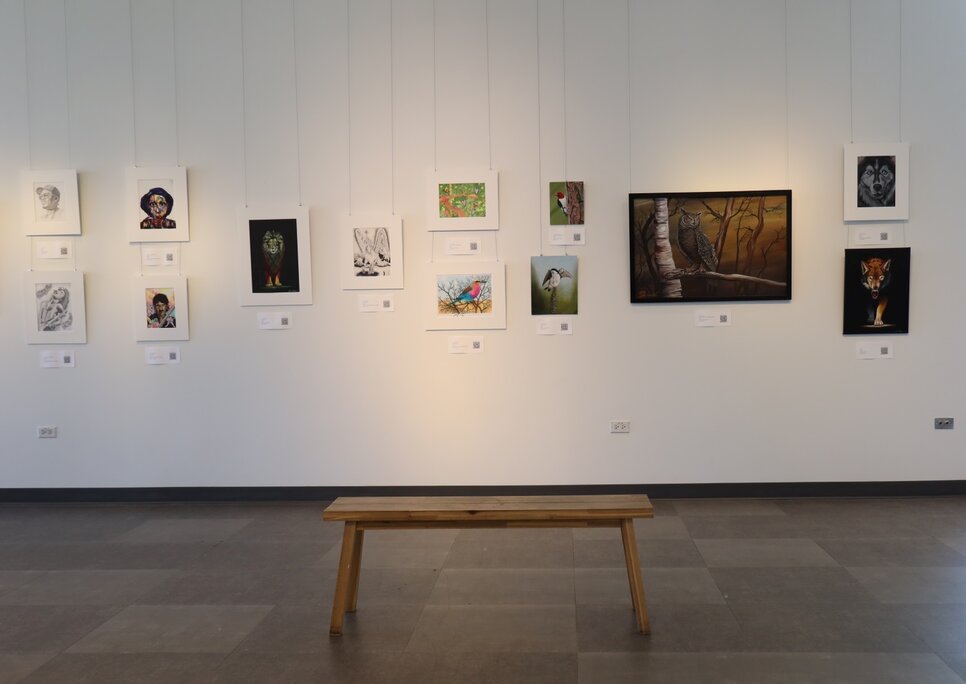
The Unchained Voices exhibit is on display at the Boulder Public Library’s Canyon Gallery until June 22.
Photo: Carly Rose, Rocky Mountain PBS
Photo: Carly Rose, Rocky Mountain PBS
McKenzie said finding a new venue to host the exhibit on such short notice was another challenge, since most art venues schedule their exhibition program more than a year in advance.
This is the first time the exhibit is being held in Boulder, since the Boulder Public Library agreed to host the show in its Canyon Gallery, which is free for the public to access.
“I definitely think this exhibition is the inaugural exhibition for whatever Unchained Voices is in the process of becoming moving forward,” McKenzie said.
The tangible — and intangible — value of art
There are 174 total artworks featured in the exhibit, with about 100 of them displayed at the gallery and the rest exclusively showcased online. All of them are for sale.
Most incarcerated people have jobs inside the facility, but they typically earn cents on the hour, with the highest pay grade capping out at $2.49 per hour. They use that money to pay restitution, send funds to family and to purchase phone calls, stamps, hygiene products, clothing and hobby supplies.
The Unchained Voices exhibit is an opportunity for the artists to receive much-needed funds to support their families, purchase necessities and buy more art supplies.
But the practical benefit of earning money through their work is just one reason why artists choose to participate in the exhibit.
“I hope that when [people] see my work, that they see a person who's changed,” Eric Laurson said.
Laurson is serving life without parole at Arkansas Valley Correctional Facility, where he’s been incarcerated since 1999. Dubbed “ the Bird Man” for his numerous depictions of birds, Laurson got into art by creating stained glass pieces in prison before trying his hand at painting.
He said his art is a source of pride for him and his family.
“I know it's something that makes my family proud — something that they can view me as other than their son or brother or father who's in prison,” Laurson said.
Each of the four pieces Laurson submitted to the exhibit depict a nature scene, whether it be birds or flowers. He said he tries to create the beauty that he doesn’t see in the prison environment.
“In here, looking at nothing but bricks and mortar and fences and stuff, it's not a lot of beauty in here,” he said. “I always try to find something beautiful to paint.”
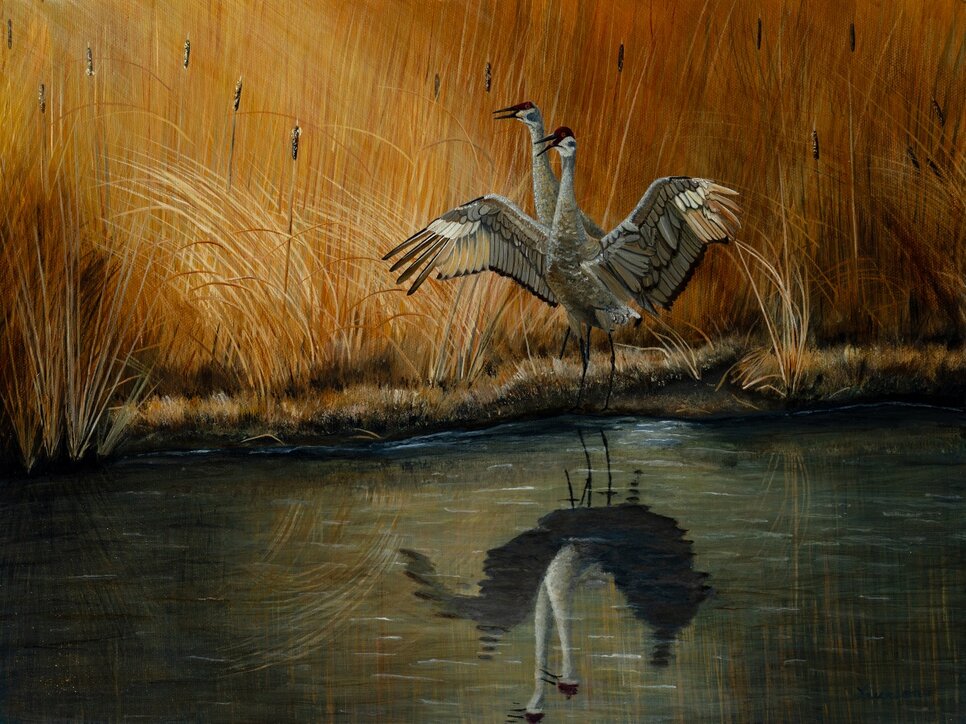
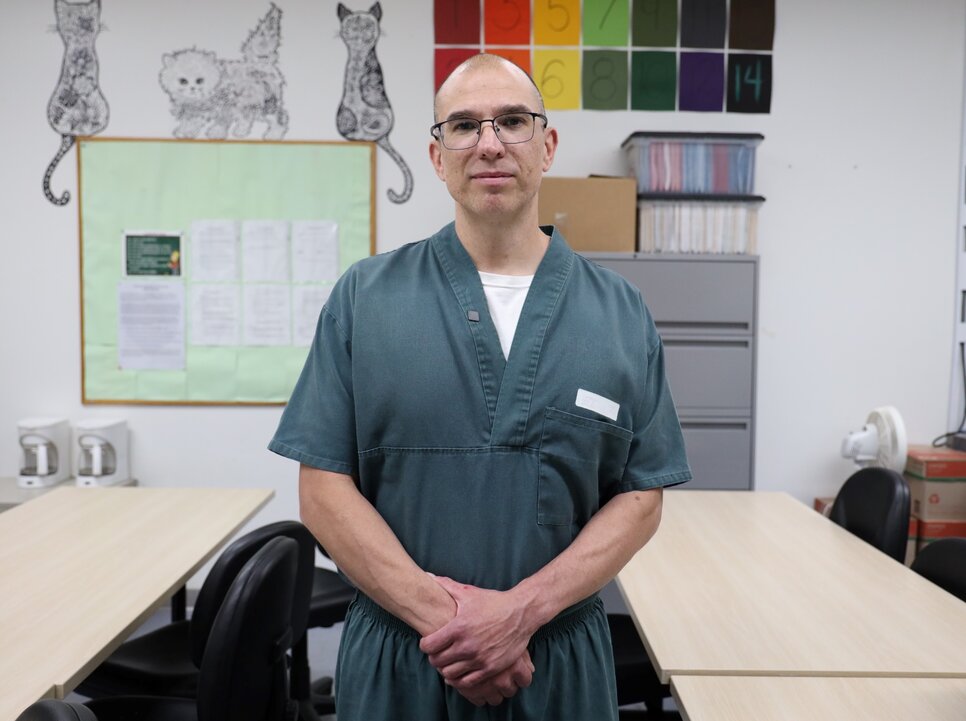
Eric Laurson’s painting “Water’s Edge” shows a sandhill crane on the edge of flight in the early morning. Photo (left): Courtesy of Unchained Voices.
Photo (right): Carly Rose, Rocky Mountain PBS
Photo (right): Carly Rose, Rocky Mountain PBS
Leilani Lynch, associate curator at the Museum of Contemporary Art in Denver, served as the guest curator of this year’s exhibit. She asked the artists to consider the theme of “Liminal Presents and Futures.” While artists were still encouraged to submit art that might not fit the prompt, the themed pieces make up a significant portion of the exhibit.
Lynch said many of the artists interpreted the theme by depicting moments of transition or being inbetween two places — rather fitting for a project in transition.
Laurson’s themed piece, titled “Water’s Edge,” shows two sandhill cranes in the early morning light — one unsure of his next move and the other with his wings spread, preparing to take flight.
“I always think of the sunrise and sunset when I think of transitions, because I used to always love watching those,” Laurson said.
Other artists, like Castillo, created pieces that directly referenced their experience in the prison system. Castillo is also serving life without parole at Arkansas Valley Correctional Facility. His themed piece, titled “78.6 Human Years,” expresses his belief that the sentence of life without parole is a “virtual death sentence.”
“I want to be a voice to the inmate population through my artwork,” Castillo said. “And voice, through art, good messages that will inspire other guys who are incarcerated to change their ways, to think outside of prison and to help change this prison culture, too.”
Castillo also makes art in the hopes of inspiring others to create. After seeing some of his work on display, Castillo said his daughter expressed her own interest in painting.
“It's an enduring, special feeling that you get when you get that kind of feedback,” he said.
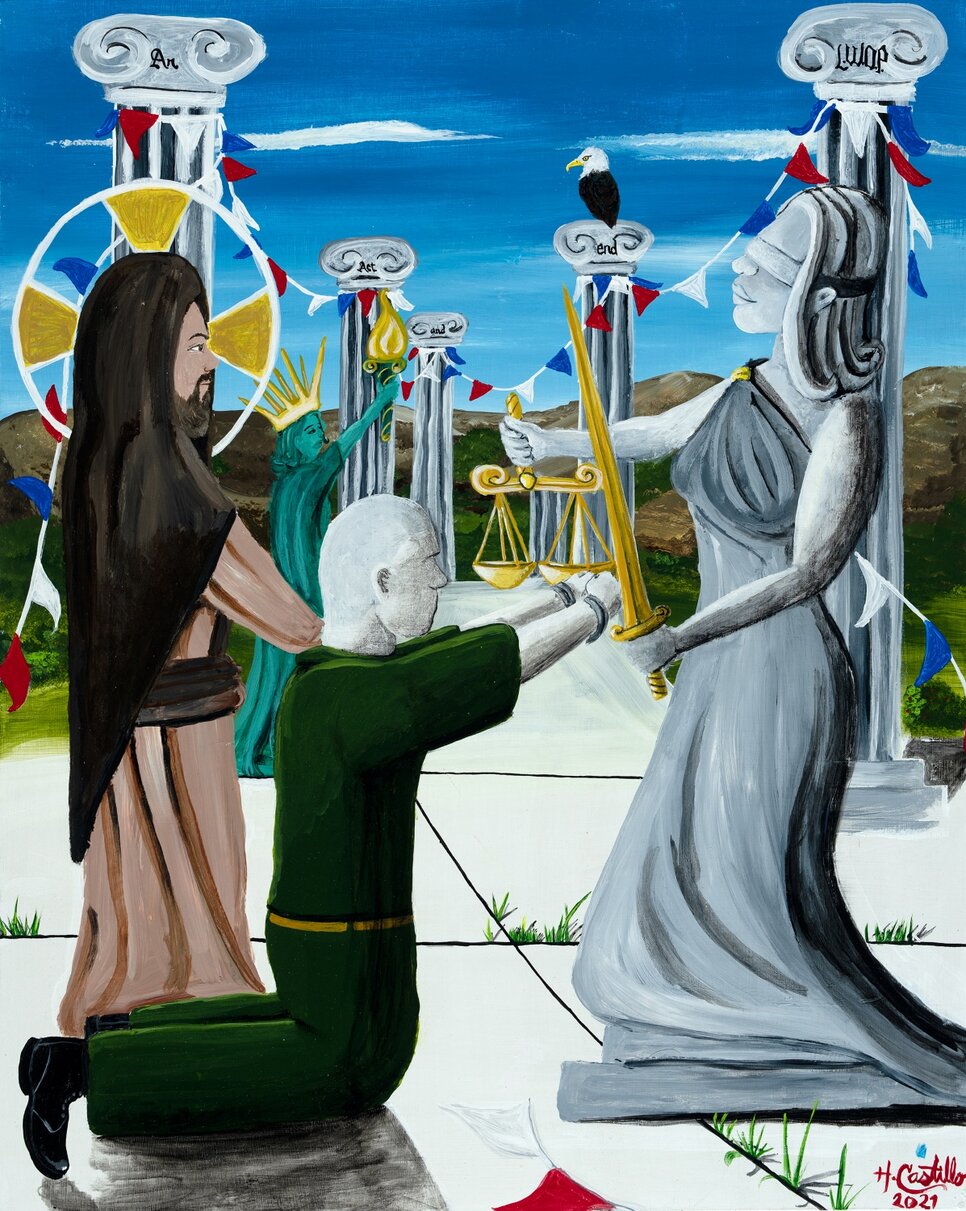
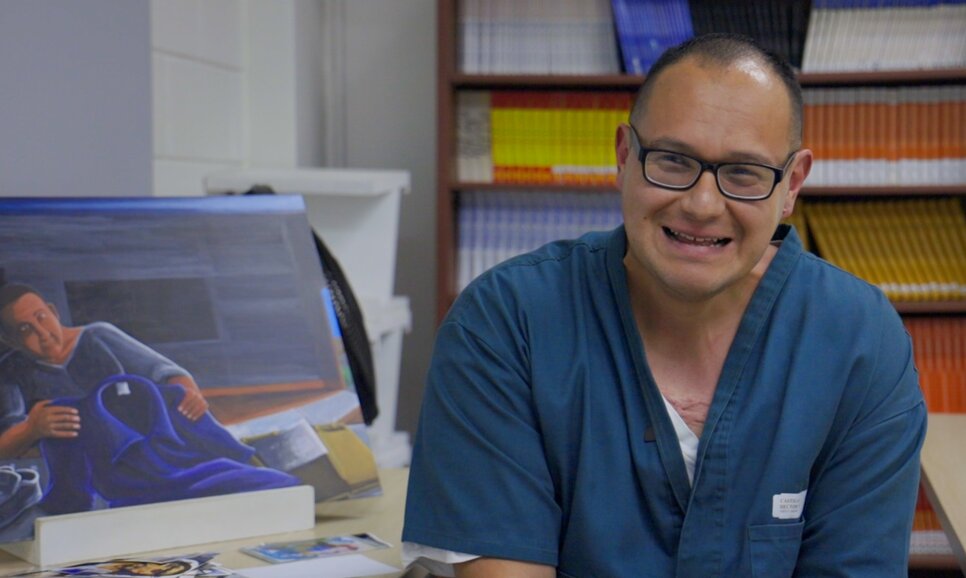
Hector Castillo’s painting “78.6 Human Years” is a commentary on the sentence of life without parole. “Human life is really, on average, 78.6 human years,” Castillo said. “Why are people being sentenced past this?”
Photo (left) courtesy of Unchained Voices. Photo (right): Carly Rose, Rocky Mountain PBS
Photo (left) courtesy of Unchained Voices. Photo (right): Carly Rose, Rocky Mountain PBS
Sonny Lee, also incarcerated at Arkansas Valley Correctional Facility, submitted three pieces to the exhibit, all of which relate to the theme and reflect his incarceration experience.
His painting titled “Tomorrow’s Hope” shows a man reaching out from a gray prison cell to a colorful cityscape. The exhibit’s organizers chose it as a promotional image for the show, which Lee said made him feel excited and proud.
“I think I try to deliver a message that we in [prison], we could change our lives for the better,” Lee said. “I just want [people] to take away that we are able to transform ourselves. We’re all human and we make bad decisions at times, and we just need a second chance and little mercy.”
While Lee hopes his artwork helps create human connection between the incarcerated population and the exhibit’s patrons on the outside, the reason he creates art is much more personal.
“I have two kids so I do it just to give back to them,” Lee said. “I'm locked up, so I'm trying to give something back in return to them to say, ‘I still care for you. Every time I do these pieces, it reminds me of you guys, and I can imagine like I'm doing these pieces like I'm here with you, trying to spend time with you guys.’”
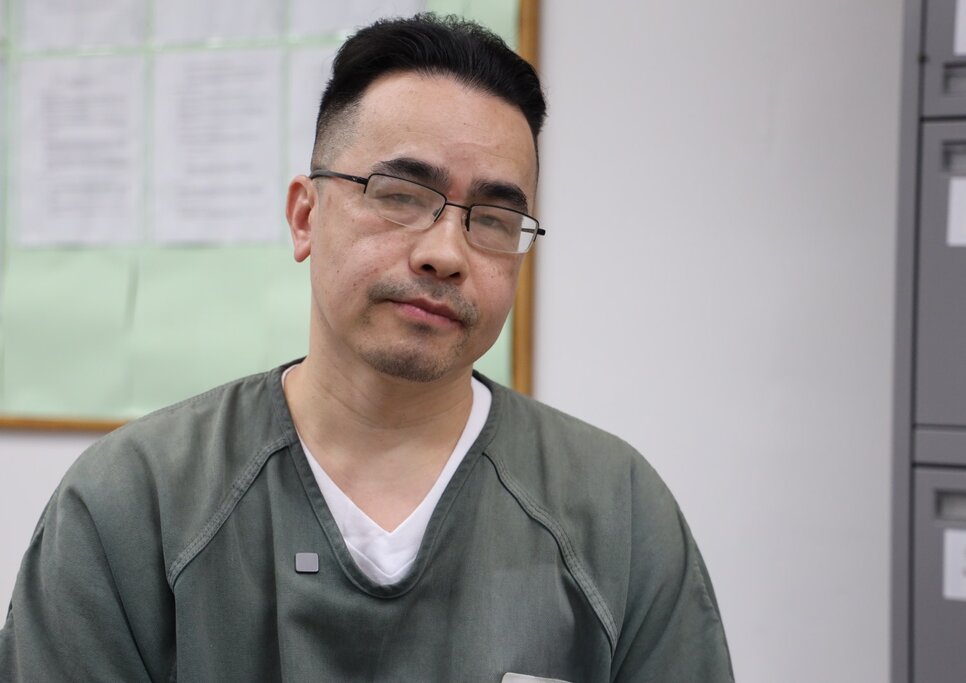
Sonny Lee’s painting “Tomorrow’s Hope”(lead image of this article) is the exhibit’s promotional image. Lee uses butterflies to represent the transformation that people can experience while incarcerated.
Photo: Carly Rose, Rocky Mountain PBS
Photo: Carly Rose, Rocky Mountain PBS
Advocacy through art
From its conception, the goal of the Unchained Voices exhibit has been to demonstrate the humanity of the incarcerated population. The exhibit’s organizers have all spent time working with people inside correctional facilities, whether it be as a social worker or an art educator.
The exhibit offers those who are less familiar with the prison system the opportunity to make that connection with a group of people who have been removed from society.
“When you see someone's artistry up close, it's impossible to not feel connected, to not feel empathy, to not see the humanity, and to remember that the decisions we're making on the outside, the people we're voting for, the policies that we're backing, impact our neighbors,” said Lilly Stannard, one of the exhibit’s organizers.
One benefit of hosting the exhibit at the public library, rather than in a traditional art venue, is that it exposes more people to the artwork, not just those who are actively seeking it out.
Emma Scher, a programs and events specialist at the Boulder Public Library said she notices visitors taking their time while viewing the pieces, often reading the description of each piece. She also said it’s quieter and more introspective than previous exhibits in the space.
“I have overheard people share the sentiment of regret knowing that people who have their artwork on display here cannot see it themselves in person, and that's a privilege for those of us who can be here to see it,” Scher said.
“You can truly hear the voices of each artist here. I think that's why it's so quiet is because their voices are really shining through,” she said.
The gallery will host a closing reception on Saturday, June 22 from 1 to 4 p.m.